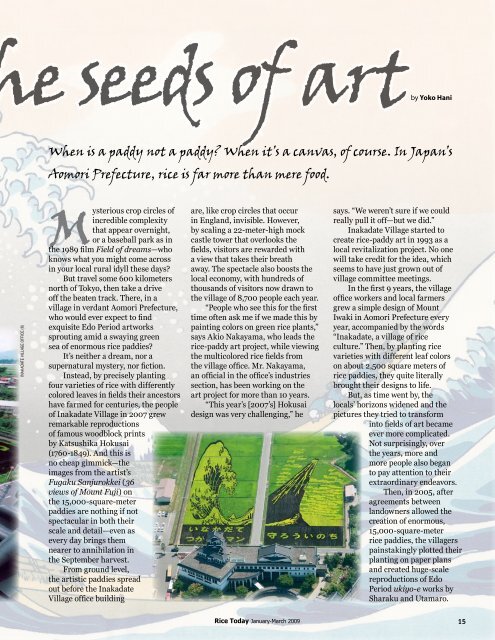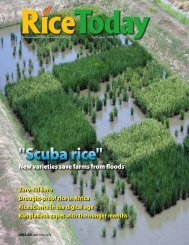How much water does rice need? - adron.sr
How much water does rice need? - adron.sr
How much water does rice need? - adron.sr
You also want an ePaper? Increase the reach of your titles
YUMPU automatically turns print PDFs into web optimized ePapers that Google loves.
e seeds of artby Yoko HaniWhen is a paddy not a paddy? When it’s a canvas, of course. In Japan’sAomori Prefecture, <strong>rice</strong> is far more than mere food.INAKADATE VILLAGE OFFICE (6)Mysterious crop circles ofincredible complexitythat appear overnight,or a baseball park as inthe 1989 film Field of dreams—whoknows what you might come acrossin your local rural idyll these days?But travel some 600 kilometersnorth of Tokyo, then take a driveoff the beaten track. There, in avillage in verdant Aomori Prefecture,who would ever expect to findexquisite Edo Period artworkssprouting amid a swaying greensea of enormous <strong>rice</strong> paddies?It’s neither a dream, nor asupernatural mystery, nor fiction.Instead, by precisely plantingfour varieties of <strong>rice</strong> with differentlycolored leaves in fields their ancestorshave farmed for centuries, the peopleof Inakadate Village in 2007 grewremarkable reproductionsof famous woodblock printsby Katsushika Hokusai(1760-1849). And this isno cheap gimmick—theimages from the artist’sFugaku Sanjurokkei (36views of Mount Fuji) onthe 15,000-square-meterpaddies are nothing if notspectacular in both theirscale and detail—even asevery day brings themnearer to annihilation inthe September harvest.From ground level,the artistic paddies spreadout before the InakadateVillage office buildingare, like crop circles that occurin England, invisible. <strong>How</strong>ever,by scaling a 22-meter-high mockcastle tower that overlooks thefields, visitors are rewarded witha view that takes their breathaway. The spectacle also boosts thelocal economy, with hundreds ofthousands of visitors now drawn tothe village of 8,700 people each year.“People who see this for the firsttime often ask me if we made this bypainting colors on green <strong>rice</strong> plants,”says Akio Nakayama, who leads the<strong>rice</strong>-paddy art project, while viewingthe multicolored <strong>rice</strong> fields fromthe village office. Mr. Nakayama,an official in the office’s industriessection, has been working on theart project for more than 10 years.“This year’s [2007’s] Hokusaidesign was very challenging,” hesays. “We weren’t sure if we couldreally pull it off—but we did.”Inakadate Village started tocreate <strong>rice</strong>-paddy art in 1993 as alocal revitalization project. No onewill take credit for the idea, whichseems to have just grown out ofvillage committee meetings.In the first 9 years, the villageoffice workers and local farmersgrew a simple design of MountIwaki in Aomori Prefecture everyyear, accompanied by the words“Inakadate, a village of <strong>rice</strong>culture.” Then, by planting <strong>rice</strong>varieties with different leaf colorson about 2,500 square meters of<strong>rice</strong> paddies, they quite literallybrought their designs to life.But, as time went by, thelocals’ horizons widened and thepictures they tried to transforminto fields of art becameever more complicated.Not surprisingly, overthe years, more andmore people also beganto pay attention to theirextraordinary endeavors.Then, in 2005, afteragreements betweenlandowners allowed thecreation of enormous,15,000-square-meter<strong>rice</strong> paddies, the villagerspainstakingly plotted theirplanting on paper plansand created huge-scalereproductions of EdoPeriod ukiyo-e works bySharaku and Utamaro.Rice Today January-March 2009 15

















